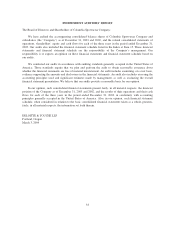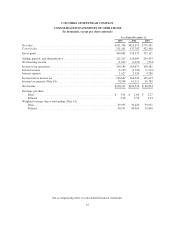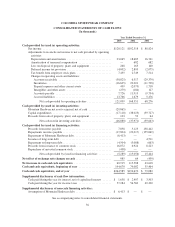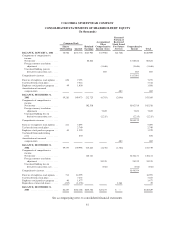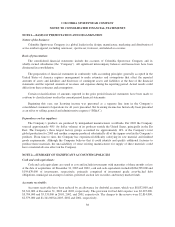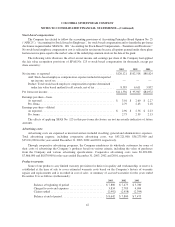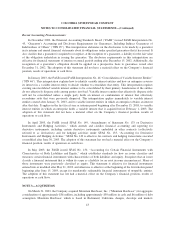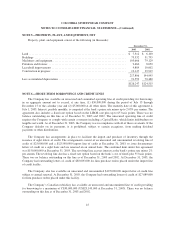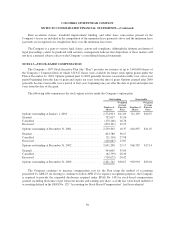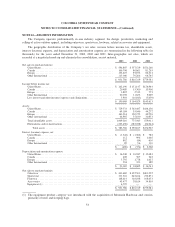Columbia Sportswear 2003 Annual Report Download - page 48
Download and view the complete annual report
Please find page 48 of the 2003 Columbia Sportswear annual report below. You can navigate through the pages in the report by either clicking on the pages listed below, or by using the keyword search tool below to find specific information within the annual report.COLUMBIA SPORTSWEAR COMPANY
NOTES TO CONSOLIDATED FINANCIAL STATEMENTS—(Continued)
Recent Accounting Pronouncements:
In November 2002, the Financial Accounting Standards Board (“FASB”) issued FASB Interpretation No.
45, “Guarantor’s Accounting and Disclosure Requirements for Guarantees, Including Indirect Guarantees of
Indebtedness of Others” (“FIN 45”). This interpretation elaborates on the disclosures to be made by a guarantor
in its interim and annual financial statements about its obligations under specified guarantees that it has issued. It
also clarifies that a guarantor is required to recognize, at the inception of a guarantee, a liability for the fair value
of the obligation undertaken in issuing the guarantee. The disclosure requirements in this interpretation are
effective for financial statements of interim or annual periods ending after December 15, 2002. Additionally, the
recognition of a guarantor’s obligation should be applied on a prospective basis to guarantees issued after
December 31, 2002. The adoption of this statement did not have a material effect on the Company’s financial
position, results of operations or cash flows.
In January 2003, the FASB issued FASB Interpretation No. 46 “Consolidation of Variable Interest Entities”
(“FIN 46”). This interpretation explains how to identify variable interest entities and how an enterprise assesses
its interest in a variable interest entity to decide whether to consolidate that entity. This interpretation requires
existing unconsolidated variable interest entities to be consolidated by their primary beneficiaries if the entities
do not effectively disperse risks among parties involved. Variable interest entities that effectively disperse risks
will not be consolidated unless a single party holds an interest or combination of interest that effectively
recombines risks that were previously dispersed. This interpretation applies immediately to variable interest
entities created after January 31, 2003, and to variable interest entities in which an enterprise obtains an interest
after that date. It applies in the first fiscal year or interim period beginning after December 15, 2003, to variable
interest entities in which an enterprise holds a variable interest that it acquired before February 1, 2003. The
adoption of this statement did not have a material effect on the Company’s financial position, results of
operations or cash flows.
In April 2003, the FASB issued SFAS No. 149, “Amendments of Statement No. 133 on Derivative
Instruments and Hedging Activities,” which amends and clarifies financial accounting and reporting for
derivative instruments, including certain derivative instruments embedded in other contracts (collectively
referred to as derivatives) and for hedging activities under SFAS No. 133, “Accounting for Derivative
Instruments and Hedging Activities.” SFAS No. 149 is effective for contracts and hedging transactions executed
or modified after June 30, 2003. The adoption of this statement has not had a material effect on the Company’s
financial position, results of operations or cash flows.
In May 2003, the FASB issued SFAS No. 150, “Accounting for Certain Financial Instruments with
Characteristics of Both Liabilities and Equity,” which establishes standards for how an issuer classifies and
measures certain financial instruments with characteristics of both liabilities and equity. It requires that an issuer
classify a financial instrument that is within its scope as a liability (or an asset in some circumstances). Many of
those instruments were previously classified as equity. This statement is effective for financial instruments
entered into or modified after May 31, 2003, and otherwise is effective at the beginning of the first interim period
beginning after June 15, 2003, except for mandatorily redeemable financial instruments of nonpublic entities.
The adoption of this statement has not had a material effect on the Company’s financial position, results of
operations or cash flows.
NOTE 3—ACQUISITION
On March 31, 2003, the Company acquired Mountain Hardwear, Inc. (“Mountain Hardwear”) for aggregate
consideration of approximately $36 million, including approximately $30 million in cash and $6 million of debt
assumption. Mountain Hardwear, which is based in Richmond, California, designs, develops and markets
43


